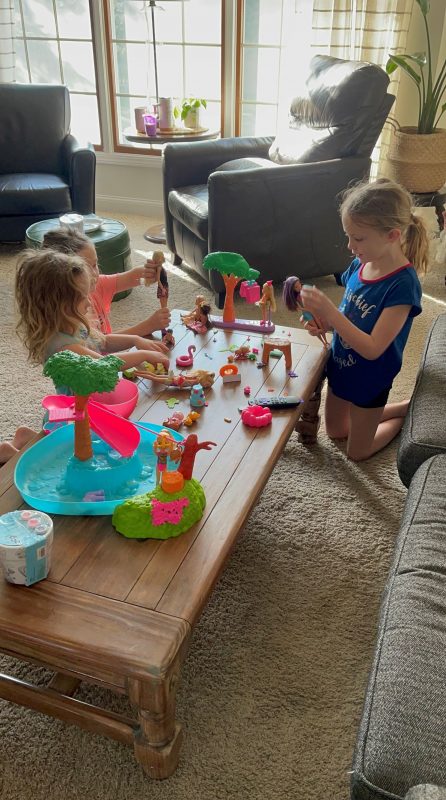In every family, there is always one family member who seems to set the tone for the rest of the family. For Jessica and Shane Rine, their daughter, Ruby, age 7, is that person.
Ruby, who lives in Tallmadge, is the couple’s first-born child, as well as the first grandchild and niece in both Jessica’s and Shane’s families. With many of Ruby’s grandparents, aunts and uncles living nearby, Ruby is used to being the center of attention in a room full of adults.
“She is very engaging, smart and active,” said Jessica. “Ruby wants to be involved with everything.”
Something wasn’t right
Despite Ruby’s many interactions with the adults in her life, it took awhile before they realized her movements and behaviors had changed. When she no longer wanted to swing on the monkey bars or jump out of the family’s van, her parents began to notice the differences, especially when compared to her younger sister.
“Ruby woke up from naps and moved very slowly,” Jessica said. “I thought to myself, ‘She looks like a little old woman in the way she moves.’”
There were other signs, too. For instance, when Ruby played outside, she complained of being tired quickly and wanted to go inside to lay on the couch.
“I watched how she ran. She used the sides of her feet instead of putting all her weight on her feet,” Jessica said. “I mentioned this to other people, and they noticed it, too.”
The couple grew more concerned when Ruby woke up at night crying, yet couldn’t explain what bothered her.
Searching for a diagnosis
That’s when Jessica searched online. She looked up autoimmune diseases, which ran in Shane’s family. Jessica discovered that arthritis is a type of autoimmune disease.
Armed with this information, Jessica took Ruby to see her pediatrician, who initially didn’t think arthritis was the problem. Jessica wasn’t convinced. Several weeks later while with her extended family, Jessica shared her concerns with her uncle, an emergency room physician. At first, he told her not to worry, but after a few days of observing Ruby, he saw how stiffly she moved. He encouraged Jessica and Shane to find a pediatric rheumatologist, who specializes in evaluating and treating joint, muscle and bone disorders.
“I sobbed,” Jessica said. “I was pregnant and emotional. It was upsetting to think that Ruby was in pain and we never knew it.”
Jessica made an appointment with Dr. Kathryn Cook, Akron Children’s pediatric rheumatologist. During the first exam, Dr. Cook diagnosed Ruby’s condition as juvenile idiopathic arthritis (JIA), the most common form of juvenile arthritis.
“From the very first meeting, Dr. Cook was amazing, the way she helped us understand the disease and answered all our questions,” said Jessica. “Even though Ruby is thin, Dr. Cook detected fluid build-up in Ruby’s knees and fingers, which signaled inflammation in her body.”
Dr. Cook also calmed Jessica’s and Shane’s fears about their other children developing juvenile arthritis, saying it was very unlikely.
Understanding juvenile arthritis
Dr. Cook explained to the Rines how rare juvenile arthritis is, nor have researchers found what causes JIA. In the United States, there are approximately 300,000 kids and teens under the age of 16 who have some form of juvenile arthritis. Left untreated, the disorder causes pain, impacts quality of life and affects bone development and joint function.
“The important thing with juvenile arthritis is getting the symptoms under control and into remission,” Dr. Cook said. “The medications we use can have side effects, so once the child is stable in remission on medications for a period of time, our goal is to get them off the medication.”
In Ruby’s case, they tried a NSAID (nonsteroidal anti-inflammatory drug). When that didn’t stop the inflammation, Ruby received methotrexate injections weekly, then later, twice a month.
During the pandemic, Ruby sometimes used telehealth to see Dr. Cook.
“Whether Ruby sees Dr. Cook in-person or for a telehealth check-up, Dr. Cook uses the same process, checking Ruby’s hands and asking questions,” Jessica said. “Dr. Cook is so good. She knows what she’s looking for, even while examining Ruby through a phone.”

Now that Ruby’s inflammation is under control, Ruby (right) can play with her sisters without any pain.
Getting good news
In August, 2020, Ruby received good news.
“Our goal was to get Ruby into remission, and she was able to stop her medicine last August, 2020,” Dr. Cook said. “The type of arthritis Ruby has can show up between ages 3 to 5 or in the teenage years. Her family caught it quickly.”
With regular treatment, Ruby attends school and does all the activities she enjoys, including gymnastics, tennis, rollerblading, bicycling and swimming. In the fall, she plans to try cheerleading and basketball.
Although puberty might affect her arthritis, for now, Ruby is enjoying life medication-free.
“Ruby is older now and can tells us if she feels pain or has an issue,” Jessica said. “It’s wonderful to see her playing non-stop all day, every day.”









